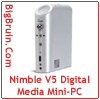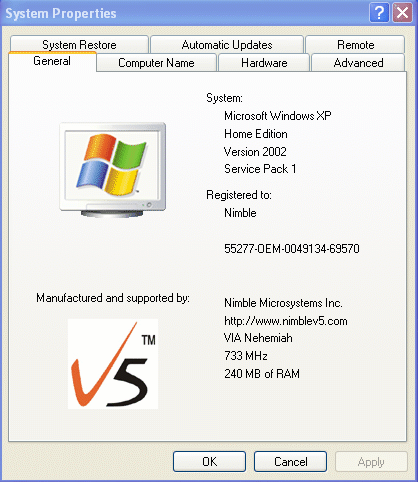|
 Posted: December 18, 2003 Posted: December 18, 2003
Author: Jason Kohrs
Manufacturer: Nimble
Source: Logic Supply
Hardware / Software:
The Nimble V5 can be purchased with or without an operating system, with respective prices of $699 and $599 (US). If you opt for the operating system, you will receive Windows XP Home Edition on CD, as well as being pre-installed and configured for the necessary hardware included. Upon booting up for the first time you are lead through the brief Windows XP activation/registration process and soon find yourself at the typical XP desktop.
Other than the core components of Windows XP and a limited license of Norton AntiVirus 2003, there are no additional software titles bundled with the package. Without anything fun to play with, the first thing I investigated was the Windows System Properties screen, as seen in the screen capture below.

As you can see, Nimble has customized the screen to feature some of their details, but the key data is still there, confirming that the system houses a 733 MHz VIA Nehemiah processor, 240 MB of memory available to the system, and that Windows XP Home Edition is patched through SP1 (Service Pack 1). Although the system physically has 256 MB of PC2100 DDR installed, at this point I have allocated 16 MB of it to serve as video memory.
For those unfamiliar with the various VIA processors, the Nehemiah followed the Ezra, and was released earlier in 2003. It provided a serious performance upgrade over previous chips (even at the same clock speed). Some of the main differences between the Ezra and Nehemiah cores are listed below:
ē Nehemiah features a full speed FPU (floating point unit), Ezra features a half speed FPU.
ē Nehemiah features Intel's SSE Technology, Ezra utilizes AMD's 3DNow Technology.
ē Nehemiah features a hardware based random number generator, Ezra does not. PadLock Data Encryption Engine: The random number generator of the Nehemiah, provides for increased data security without the need for extra software. The Nehemiah is the first x86 processor on the market with such a feature, and looks to be of great interest with the increase in PC networking and Internet-based commerce.
Video: The Nimble V5 features a VIA CLE266 chipset that makes use of S3 based integrated video that shares system memory in BIOS configured chunks of 16, 32, or 64 MB. These choices should be more than adequate for the functions this device was intended to perform. Donít expect to play the latest 3D games on the Nimble, because if the video didnít limit the performance, you would surely hit a bottleneck in cpu speed, or the hard drive data transfer rate. The only connection for video output is a standard 15-pin connection, and the simple addition of a composite or S-Video connection would greatly increase the multimedia appeal of the device. Many people use televisions as secondary (or often primary) displays for computers, and the style, size and silence of the V5 would fit nicely in a home entertainment environment.
Audio: The audio chipset provided on the Nimble V5 is compatible with the AC 97 codec, which is a common choice for integrated sound solution. Although AC 97 is getting up there in age, it is capable of providing up to 6 channel sound for low-mid range systems. However, other than the onboard speaker, the Nimble V5 only provides 2 channel stereo output, mostly intended for headphone use. As with the video output, providing greater flexibility with the Nimble V5ís sound would greatly enhance its appeal to a multimedia environment. Despite this issue, the audio on the V5 is highly capable when used for video conferencing. Coupled with the Logitech QuickCam 4000, the integrated microphone and speaker allow for clear, echo-free communications. The addition of external (stereo) speakers and the wired microphone only enhance the experience.
Networking: The dual Ethernet connections, driven by the RealTek RTL8139 chipset, make the Nimble V5 ready for basic network operations, as well as for use as an internet connection sharing device, and could even be configured to serve as a firewall, if the user desired. Because of its extremely low power consumption, 24/7 operation would be economical in this application.
In addition, the CLE266 chipset supports USB 2.0, which is accessible via 3 ports on the rear, and one on the front of the device. Not found on the Nimble V5 is a firewire connection, which is surprising. Firewire has widespread appeal as a high-speed connection, and is generally the connection of choice for digital video.
Please read on to page four for the benchmarking of the Nimble V5... Next
Page 1 | Page 2 | Page 3 | Page 4 | Page 5 | Page 6 | Forum | Review Index
|